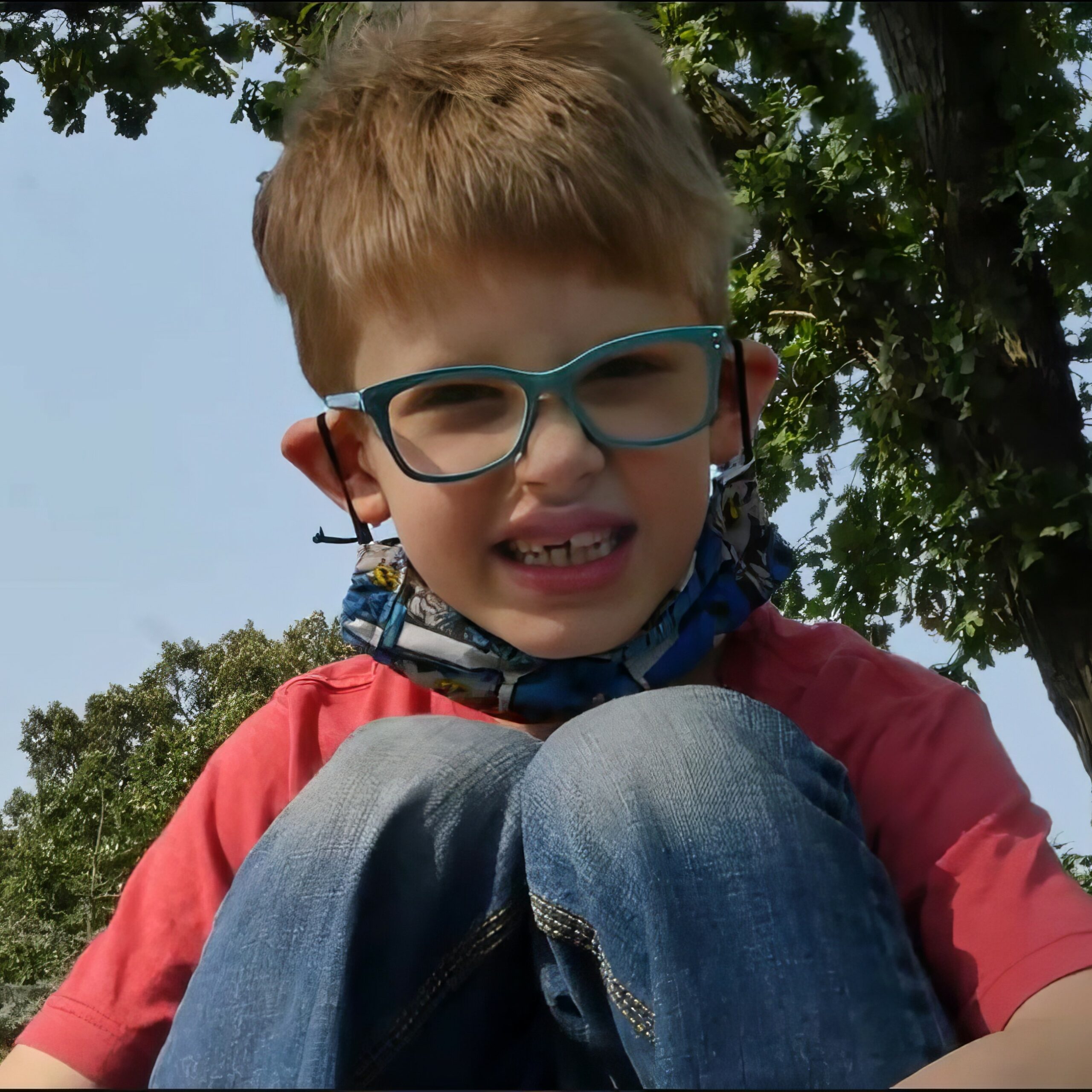The Unique Connection Between Eyeglasses and Hearing
“I love my glasses because they help me hear better."
Those words (quote above) – from first-grader Elijah (Eli) – usually elicit a “huh?” from most people, according to his mother, Becky. “Glasses are supposed to help you see better – not hear better.”
But, for Elijah, diagnosed as being on the autism spectrum, the “brain” glasses prescribed by the Mind-Eye Institute, based in Northbrook, Ill., have done just that – improved his listening capabilities. “They have synchronized his eyesight and hearing, and the results have been profound,” Becky relates.
“I always wondered why Eli never looked us in the eye when we talked to him. He would look to the side or behind him,” Becky says. “But, during his extensive testing at the Mind-Eye Institute, I had an ‘Aha’ moment. Because Elijah’s visual and auditory sensory systems were uncoordinated, he was unsure where sound was coming from when someone was talking. That’s why he would keep looking around.”
His “brain” glasses have changed all that.
Elijah's Journey: Autism Spectrum and Sensory Integration

“Today, he looks people in the eye. He responds to questions better. He can hold a conversation. In the past, when other children came to the house to play, he would go off to a corner and play by himself and would not interact unless prompted by another child. That’s not the case anymore.”
In fact, within a week of receiving his first pair of glasses, Elijah no longer experienced outbursts “when he would get upset and knock things down or toss things around or just throw himself on the ground,” Becky says. “Now, he is able to be calmed or to calm himself down.”
The Science Behind Brain Glasses: Visual and Auditory Coordination
“The self-regulation Elijah is developing is partially due to the retina’s connection with parts of the brain regulating moods,” says Deborah Zelinsky, O.D., founder of the Mind-Eye Institute and also Elijah’s optometrist.
The glasses also have enabled Elijah to participate in classes at school, including his physical education (PE) class – “something he had never been able to do before,” Becky says. “Before his glasses, PE had been just too overwhelming for him. It was too loud, and there were too many kids running around. He simply could not follow what he was supposed to do.”
Equally rewarding, “within about 10 days of wearing his new glasses, Eli began sleeping through the night,” Becky recalls. “Eli always had trouble sleeping. He oftentimes would be up until midnight or 1 a.m. playing with his toys. But, thanks to his glasses, he now falls asleep easily – which is incredible – and a blessing to us as parents. We appreciate the extra sleep.”
Visual Processing, the Retina, & Mind-Eye Brainwear™
The Mind-Eye Institute is recognized worldwide for its assessments of “visual processing.” The term refers to the brain’s almost-instantaneous ability (partially beneath a conscious level of awareness) to take in external sensory signals (from eyesight, hearing, smell, taste and touch), meld them with a person’s internal sensory signals and then synthesize – process — the information, allowing a person to react and respond to his or her environment.
“The retina is composed of brain tissue and is part of the central nervous system. By changing the way light passes through the retina, we can affect how the brain reacts to information about the environment and modify a person’s spatial awareness, body posture and selective attention to sound,” says Dr. Zelinsky.
Through careful modulation of retinal signaling using customized, therapeutic “brain” glasses — Mind-Eye Brainwear™– and other optometric techniques, the Mind-Eye Institute is helping those patients who have learning or comprehension challenges, such as attention deficit and autism spectrum disorders, to develop new visual skills.
Visual Processing in the Classroom Environment
“Visual processing and awareness are essential to all aspects of learning,” Dr. Zelinsky says. “The brain simultaneously integrates sensory information from the right and left eyes and ears, as well as signals from each inner ear, and fibers in some muscles, such as the neck and feet. If these signals are mismatched, the brain makes the body fidget, searching for a posture in which eyes and ears can work together. Constant fidgeting, often diagnosed as ADD – attention deficit disorder, sometimes can be the result of a child’s search for eye-ear integration.”
“Children who struggle with reading, for example, likely have underdeveloped visual processing skills. These skills have nothing to do with 20/20 eyesight."
-Deborah Zelinsky, OD
To achieve optimal school performance, “students must be able to integrate their many sensory systems in order to maintain awareness of facial expressions and body posture, while also looking at information presented on a classroom screen. Students have to simultaneously listen and think about what the teacher is saying, while shifting gaze from place to place,” she explains. “Children who struggle with reading, for example, likely have underdeveloped visual processing skills. These skills have nothing to do with 20/20 eyesight. A person requires multiple visual skills to attain solid, fluent reading ability. It’s not simply a matter of knowing the letters.”
Becky recalls Dr. Zelinsky explaining to her that lack of coordination between Elijah’s visual and auditory sensory systems caused him to be overwhelmed by his environment, to constantly operate at an abnormally high stress level. “That’s why any increase in this stress would push him over the edge.”
A Mother's Advocacy: Outsmarting Autism and Looking Ahead
Like other parents of children with developmental and learning challenges, Becky and her husband first turned to the standard health care system for assistance with Elijah. “It took nine months just to get an appointment because there are so few specialists in this field. I felt I had to research everything on my own,” Becky says.
And research is exactly what she did, enrolling Elijah in a variety of different developmental programs – occupational therapy, speech therapy, even therapeutic horseback riding classes. However, it was Suzi Marks, owner of Mindful Movement in Highland Park, Ill., who recommended Elijah be seen by the team at the Mind-Eye Institute. Suzi practices the Anat Baniel Method of NeuroMovement.
Becky took her advice and now says the results of the Institute’s work have far exceeded her expectations.
“Parents might think the Institute sounds too good to be true, but it definitely is true,” she says. “Eli is proof of that.”
-Eli's Mother, Becky
“Even family members and friends have noticed the changes in Eli since he has been wearing his Mind-Eye glasses,” states Becky, brushing off suggestions that other therapy programs may be primarily responsible. “We have not been attending other therapy programs since the COVID-19 pandemic started, yet Eli has been thriving. I credit the glasses with helping him cope better and learn more. I feel every moment he is wearing them they are having positive effects on his brain. Perhaps, over time, these changes will become permanent, and he will not need the glasses.”
Indeed, Becky is so pleased she is even thinking of creating an organization or foundation that would support and encourage other parents of children with autism spectrum disorders to seek care at the Mind-Eye Institute.
“Parents might think the Institute sounds too good to be true, but it definitely is true,” she says. “Eli is proof of that.”
Dr. Zelinsky’s work is included in the second edition of Patricia Lemer’s 2019 book Outsmarting Autism.
For more information, go to www.mindeye.com or read Becky’s blog.


